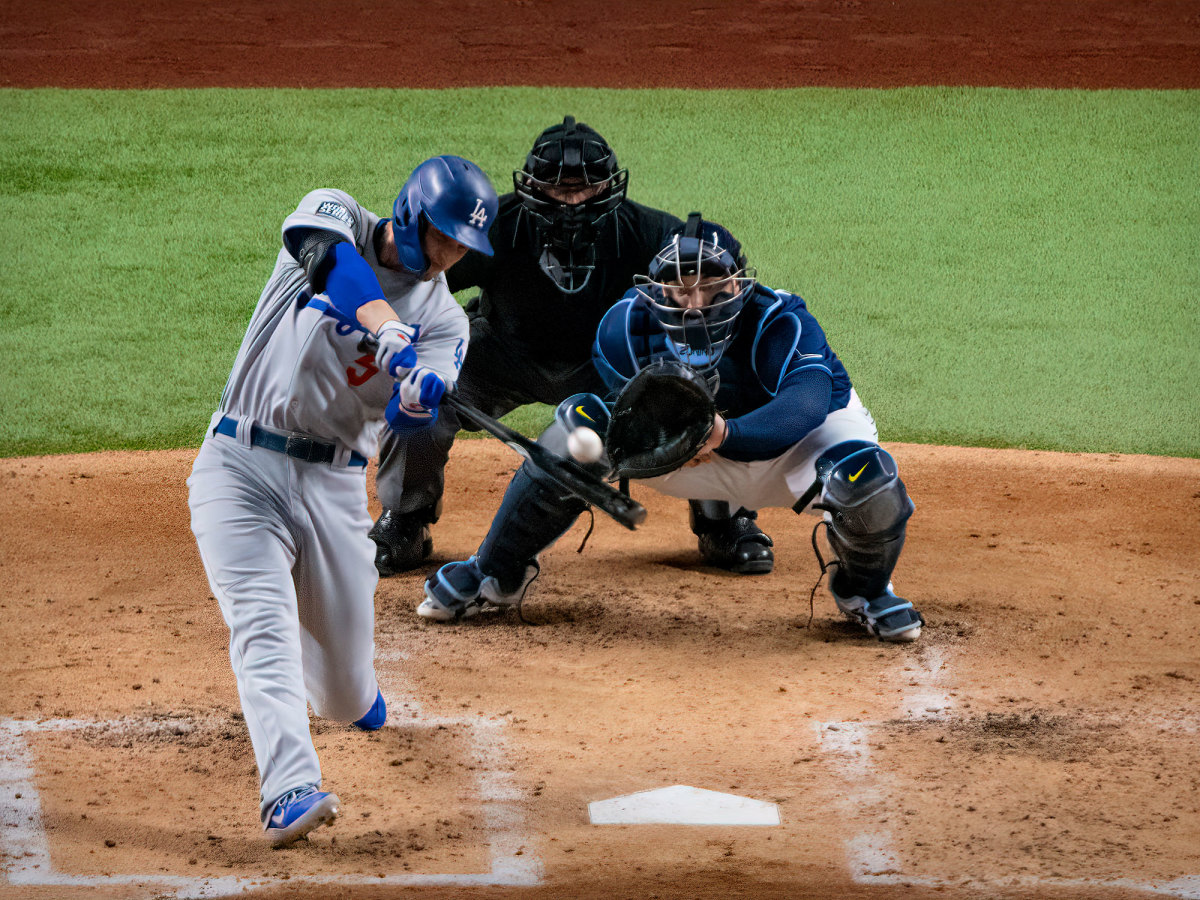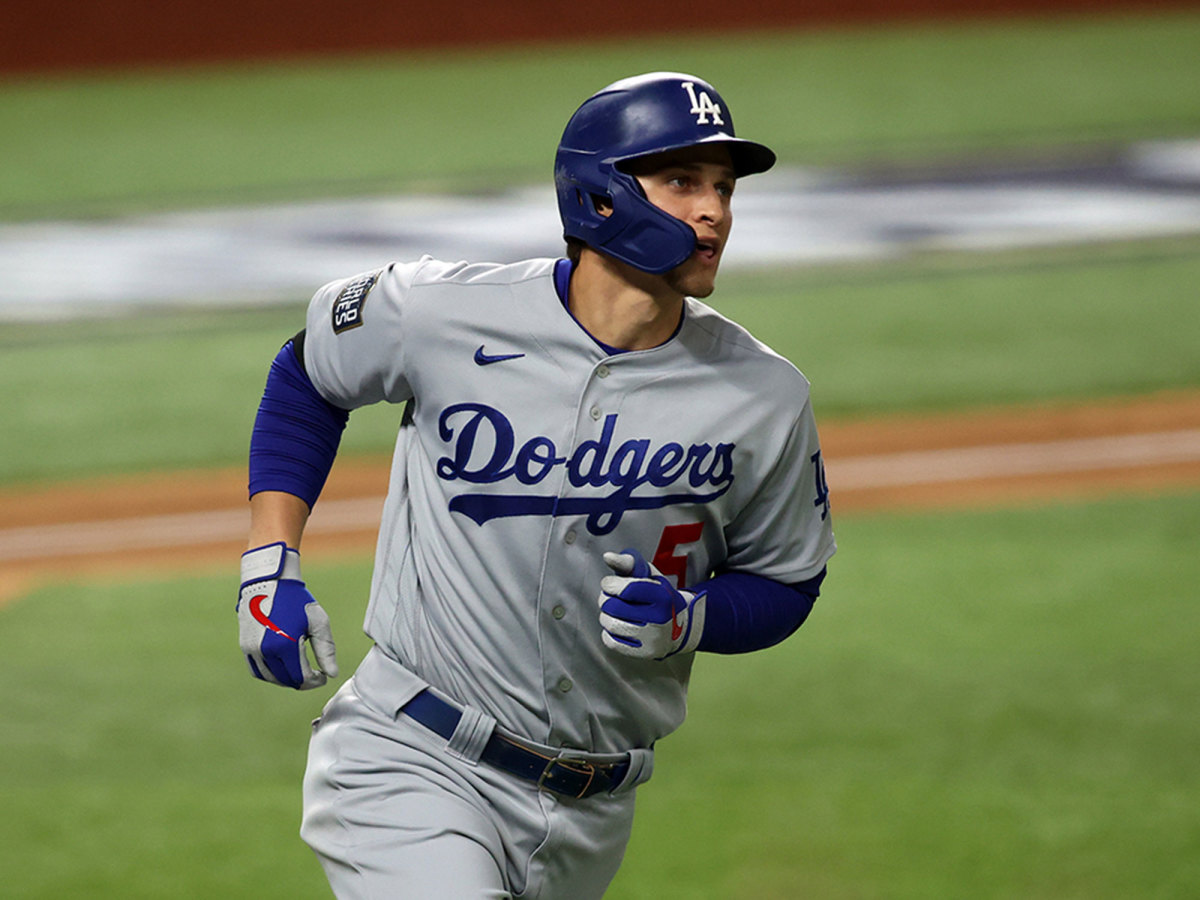With Injuries Behind Him, Corey Seager Is Lighting Up October
ARLINGTON, Texas — As the pandemic-induced baseball hiatus stretched into its third month this summer, workers at Dodger Stadium finished a $100 million renovation to the center field area. Shortly thereafter, shortstop Corey Seager set about destroying it.
“Our poor wall,” strength coach Brandon McDaniel says now. “I’m serious. It was every [at bat], just thunk, thunk, thunk. The poor construction workers.”
Seager, 26, has done similar damage to the stands this October at Globe Life Field, where—despite not playing for the Rangers—he is now the all-time home run leader, with eight. He was the MVP of the National League Championship Series. If the Dodgers win the World Series, which they would do with a win in Tuesday’s Game 6, his absurd .471 average and 1.432 OPS give him a good chance to be the MVP of that, too. That would be a fitting end to the best season of his career—and among the most challenging.

***
This was supposed to be Seager’s year. The onetime phenom—No. 18 pick in the 2012 draft out of high school, major league debut at 21, Rookie of the Year at 22—suddenly found himself the topic of trade rumors. He will reach free agency after the 2021 season, and after three seasons marked by injury, Los Angeles seemed inclined to let him get there. The Dodgers were said to have dangled him as the return for Mookie Betts or Francisco Lindor. In the end, they got Betts without giving up Seager, but it was clear that the erstwhile franchise cornerstone was now touchable.
But he was also something else: healthy. After a stellar regular season, he had hurt his back sliding into second base in the 2017 National League Division Series and missed the NLCS. In April ’18, after months of pain in his right elbow, he was diagnosed with a torn ulnar collateral ligament. He underwent Tommy John surgery and missed the rest of the season. Last February, he went back to the operating room to have the labrum in his left hip repaired.
The doctors found a birth defect: His left hip bone was not completely circular. The edge had been rubbing against the labrum; it would have torn later in life if he’d been an accountant, but his profession sped up the decline. They shaved down the bone to reshape it.
“They told us that if the hip’s not right, that would restrict his back and that might have caused some of his back problems,” says his father, Jeff. “And they said the hip also could cause hamstring problems, which are some of the ones that he's had. And they actually even said that if your hip’s bad and locks up parts of your back, then it puts more strain on your arm, and even his Tommy John could have been part of that.”
So Seager had his health, and he had answers. Last season, he hit .272 and led the league in doubles, with 44. And yet, he often lamented, he never felt truly strong. He had spent the offseason rehabbing from the surgeries and allowing himself to take the field, but that just got him to neutral. He wanted to be better.
He spent this past winter putting on muscle. By the time McDaniel visited him in Seager’s hometown of Charlotte in January, the strength coach noticed a change. Wow, he remembers thinking. Completely different.
Seager hit .441 with four doubles and a home run in 13 spring training games. Those around the facility in Glendale, Ariz., commented on how good he looked. And then everything stopped.
***
Playing amid a pandemic has required significant adjustments from everyone, but especially so from Seager. Before this year, the shortstop could have had his mail forwarded to the batting cage, where he tried to swing away any flaws. But he has had to cut back: COVID-19 regulations keep players away from the field until five hours before game time and limit the number of people who can be in the cage at one time. He has to wait his turn.
Even worse are the protocols dictating where he can be during a game. Until 2020, he had spent some two-thirds of his offensive innings as a Dodger in the video room, studying film of his most recent swings, trying to patch holes before his next at bat. But this year's rules bar players from visiting that area mid-game—too many people, too small a space. So they must make in-game adjustments the old-school way: by paying attention to what they feel.
These deviations in routine have been challenging for a young man who used to insist that his mother buy the same flavor of Big League Chew (Outta Here Original) before each of his games. He has spent the whole season feeling slightly out of sorts.
But in other ways, he has benefited from the strangeness of this year. The shutdown gave him extra time to continue the running program the team had devised to strengthen his legs and improve his range of motion. It gave him one-on-one time with the coaching staff, who were allowed to work with players only individually. It also gave him time to listen to his body.

“It just allowed for so much more to be said, to be heard, to be played with,” says McDaniel. “And in a very non-threatening environment. Because we spend the most time with guys in season, the time when it's the hardest to make changes. If you're oh-for-four or four-for-four the night before, that's what's on your mind. And during quarantine, it was like, ‘Don’t catch COVID, and come do your work.’”
Seager’s work, it soon became clear, involved ruining baseballs. In the cage, off the machine, during live batting practice—no matter where the ball came from, it ended up far away. The extra work during the shutdown helped improve his stability in the batter’s box. Dodgers staffers joked that he seemed to be swinging a Wiffle ball bat. He hit .307 and slugged .585 this year. His 28 extra-base hits in 52 games were the eighth most in the NL. And he felt strong.
So he lost his favorite tools and then he produced his best season. Health played a key role, as did his training regimen. But is there more to it than that? Has the forced simplicity been good for him?
His mom, Jody, thinks so. “Maybe he studied the videos too much and stressed over them,” she says.
So does manager Dave Roberts. “He’s uncomfortable, doesn’t like it, but you still can flourish [without] things that you really think you need,” he says. “I hope that he looks back on 2020 and thinks, I might not need it as much as I thought I did, because I’m a heck of a ballplayer.”
Perhaps someday Seager will draw that conclusion. But today is not that day. “It’s been a year of relying on feel, and that can be good and bad,” he acknowledges. “But for the most part, I'm excited for it to go back to normal.”
